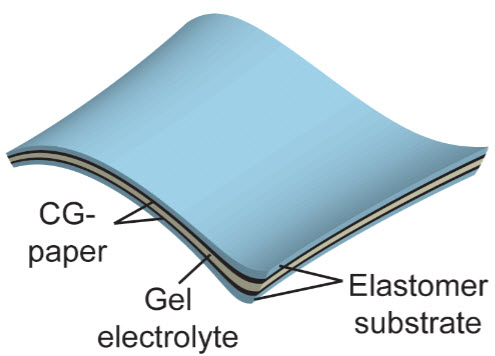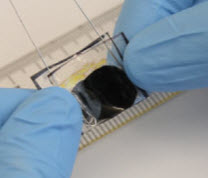Supercapacitors from ‘crumpled graphene’ could power flexible electronic devices
October 7, 2014

To form crumpled graphene, a sheet of polymer material is stretched in both dimensions, then graphene paper is bonded to it. When the polymer is released in one direction, the graphene forms pleats (bottom left). Then, when released in the other direction, it forms a chaotic crumpled pattern (top left). Top right: the material in a partially crumpled state. Bottom right: a piece that has been crumpled and then flattened out. Images are from a scanning electron microscope (SEM). (Credit: Jianfeng Zang et al.)
MIT researchers have found that crumpling a piece of graphene “paper” — a material formed by bonding together layers of the two-dimensional form of carbon — can yield new properties that could be useful for creating extremely stretchable supercapacitors to store energy for flexible electronic devices.
The finding is reported in the journal Scientific Reports (open access) by MIT’s Xuanhe Zhao, an assistant professor of mechanical engineering and civil and environmental engineering, and four other authors.
Flexible electronic devices, such as wearable or implantable biomedical sensors or monitoring devices, will require flexible power-storage systems.
Like batteries, supercapacitors can store electrical energy, but they primarily do so electrostatically, rather than chemically, so they can deliver their energy faster than batteries.
Graphene paper is a “good candidate for making supercapacitors, because of its large surface area per mass,” Zhao says.
By crumpling a sheet of graphene paper into a chaotic mass of folds, a supercapacitor can be made that can easily be bent, folded, or stretched to as much as 800 percent of its original size. The team has made a simple supercapacitor using this method as a proof of principle.
The material can be crumpled and flattened up to 1,000 times, the team has demonstrated, without a significant loss of performance.
How to make crumpled graphene

A diagram of a supercapacitor using crumpled-graphene-paper electrodes with a polymer electrolyte gel as the electrolyte and separator (credit: J. Zang et al./Scientific Reports)
To make the crumpled graphene paper, a sheet of the material was placed in a mechanical device that first compressed it in one direction, creating a series of parallel folds or pleats, and then in the other direction, leading to a chaotic, rumpled surface. When stretched, the material’s folds simply smooth themselves out.

An assembled supercapacitor (credit: J. Zang et al./Scientific Reports)
Forming a capacitor requires two conductive layers — in this case, two sheets of crumpled graphene paper — with an insulating layer in between, which in this demonstration was made from a hydrogel material.
Like the crumpled graphene, the hydrogel is also highly deformable and stretchable, so the three layers remain in contact even while being flexed and pulled.
Zhao says the crumpled graphene material might also be used for other purposes, such as an electrode in a flexible battery or a stretchable sensor for specific chemical or biological molecules.
Abstract of Stretchable and High-Performance Supercapacitors with Crumpled Graphene Papers
Fabrication of unconventional energy storage devices with high stretchability and performance is challenging, but critical to practical operations of fully power-independent stretchable electronics. While supercapacitors represent a promising candidate for unconventional energy-storage devices, existing stretchable supercapacitors are limited by their low stretchability, complicated fabrication process, and high cost. Here, we report a simple and low-cost method to fabricate extremely stretchable and high-performance electrodes for supercapacitors based on new crumpled-graphene papers. Electrolyte-mediated-graphene paper bonded on a compliant substrate can be crumpled into self-organized patterns by harnessing mechanical instabilities in the graphene paper. As the substrate is stretched, the crumpled patterns unfold, maintaining high reliability of the graphene paper under multiple cycles of large deformation. Supercapacitor electrodes based on the crumpled graphene papers exhibit a unique combination of high stretchability (e.g., linear strain ~300%, areal strain ~800%), high electrochemical performance (e.g., specific capacitance ~196 F g−1), and high reliability (e.g., over 1000 stretch/relax cycles). An all-solid-state supercapacitor capable of large deformation is further fabricated to demonstrate practical applications of the crumpled-graphene-paper electrodes. Our method and design open a wide range of opportunities for manufacturing future energy-storage devices with desired deformability together with high performance.